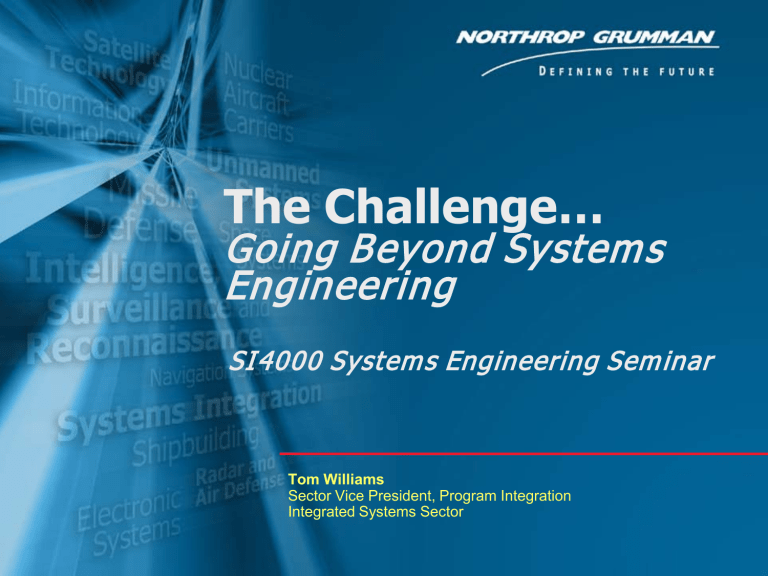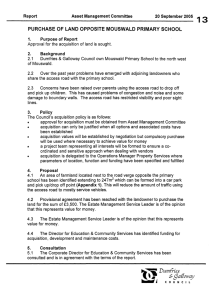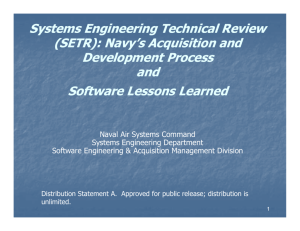
The Challenge…
Going Beyond System s
Engineering
SI 4000 System s Engineering Sem inar
Tom Williams
Sector Vice President, Program Integration
Integrated Systems Sector
What’s Wanted – “M ajor Concerns”
On Time Delivery
Within Budget
High Reliability (Missions Success)
Meet War Fighters’ Needs
Agile, Credible, Spiral Capable Development
Deliver What Is Promised, When
Promised!
Recent USAF ACAT-1C/D Program
Experience
Development
Growth Cause(s)
Actual Cost/Schedule
vs Negotiated
Contract
Acquisition
Reform (4%)
Budget
Process
(11%)
• 36% Cost Over-Runs
• 2 Year Schedule Increase
All Other
Reasons
(2%)
Requirements
Instability
(27%)
• 2% Cost Over-Run When
Compared to the Cost Assessment
Improvement Group (CAIG)
Estimate
SE Training
and Process
Disconnects
(40%)
Source: Space Systems Development Cost Growth Analysis Conducted
by Booz-Allen-Hamilton (83 Surveys of 67 Organizations)
43%
Soft Cost /
Schedule
Baselines
(16%)
Enhancing Program Performance
• Program Manager SE Training
• SE/SI Training
(Internal / External/Univ.
Affiliations)
• Architects / Integrators as
Recognized Disciplines
• Accelerate Domain
Knowledge Acquisition
• Strengthening
Material /
Procurement PM
Talent Pool
People
Knowledge
Sharing
• Corporate (CrossBusiness Area)
SE Councils – SEAG
• SE Community of
Practice & User
Groups
• People-to-People
Contact Tools
• Embedding
Processes/Knowledge
in “Closed Loop”
Workflows
Tools
Processes
• Integrate Intermediate SE
Work Products into Endto-End Business Systems
(ERP Systems)
• Willoughby-Like Program
/ Product / Process
Templates
• Integrated Analysis and
Synthesis Tools (Early
Simulation)
• Program Health Visibility
Systems
• Enhanced Risk Mgmt
Tools
• Extend Unified Modeling
Language Tools to SE
• Cross-Program Peer
Reviews Using Domain
Experts
• SE Products Precede
Downstream Design
• CMMI (SW/SE/IPPD/SS)
• Lean / 6σ
• Non-Advocate Reviews
(NAR) / Independent Cost
Evaluations (ICE) Prior to
Proposal Submittals
• Causal Analysis and
Resolution
Process Improvement
and Deployment
Quantitative
Management
Level 3
Standardized
Processes
Level 1
• Quantitative Project Management
• Organizational Process Performance
• Organizational Environment for Integration
• Integrated Teaming
• Organizational Process Focus
• Organizational Process Definition
• Organizational Training
• Integrated Project Management
• Risk Management
• Requirements Management
• Project Planning
• Project Monitoring and Control
• Supplier Agreement Management
• Measurement and Analysis
• Process and Product Quality Assurance
• Configuration Management
• Decision Analysis and Resolution
• Requirements Development
• Technical Solution
• Product Integration
• Verification
• Validation
Software
Level 4
Level 2
• Organizational Innovation
Supplier Sourcing
Level 5
Integrated Program
Product Development
Your Work
Processes
Systems Engineering / Hardware
Capability Maturity Model
“Integration” – CM M I ®
Four
Discipline
Models
Address
Different
Parts
of the
Business
Provides Architecture for Linking/Integrating of Processes
Provides a Measurement/Assessment Approach
Does NOT Assess “Goodness” of the Processes Being
Used or Number of Processes Under Control
Expanding Our Focus
Executable Programs
Program
(Structure / Infrastructure)
Integration
Product
Integration
Process
Integration
System Engineering…
….Involves Structured Requirements Analysis Allocation and Design Syntehsis
(Hierarchical Product Decomposition) DRM Associates
Going Beyond the “Product”
Manage and Integrate ALL Baselines
One Approach…
Integrated Product(s)
Program Integration
Integrated Processes
Systems Engineering
Executability Templates
“Expert System” Tailored to:
Program Life Cycle
Program Size and Complexity
Similar in Format to Willoughby
Templates
Leverages Past Company/Industry
Experience and Best Practices
How Do You Measure Good Systems
Engineering?
The Number of Successful Programs
What Is System Engineering?
Process
Inputs
Requirement
and constraint
conflicts
Requirements
IEEE
1220:
Analysis
(8 subprocesses + 75 tasks)
Requirement
Trade-off’s and
Collaborative
impacts Approach
An Interdisciplinary
to
Requirements
Requirements trade
Derive,
Evolve, and Verify a Life Cycle Balanced
Verification
studies and
Decomposition and
System
Solution
that
Satisfies
Customer
Validated
Requirements
Baseline
Requirement
allocation
assessments
Expectations
and Meets Publicalternatives
Acceptability
Functional
Requirements Baseline
System
Analysis
Functional
Architecture
Mil-Std
499B:
Decomposition / allocation
Trade-off’s and impacts
Functional trade
Studies and
Design solution
assessments
Approachrequirements
Encompassing
and
Verified Functional Architecture
alternatives
the Entire
Technical Effort to Evolve
and Verify
Analysis
an Synthesis
Integrated and Life-cycle Balanced set of
DesignProcess
solution
systemPhysical
People,
Producttrade-off’s
and
Solutions
Design trade
and impacts
Architecture
Studies and
thatDesign
Satisfy Customer Needs
assessments
Verification
Functional
AnVerification
Interdisciplinary
EIA/632
EIA 620
ISO/IEC 15288
Verified Physical Architecture
Control
Source: IEEE 1220-1998. © IEEE 1998. All rights reserved.
Process
Outputs
System Engineering Process
Requirement
and constraint
conflicts
(8 Subprocesses + 75 Tasks)
Process
Inputs
Requirements
Analysis
Requirement
Trade-off’s and
impacts
Requirements Baseline
Requirements
Verification
Validated Requirements Baseline
Functional
Analysis
Functional Architecture
Decomposition and
Requirement allocation
alternatives
Requirements trade
studies and
assessments
System
Decomposition / allocation
Trade-off’s and impacts
Functional
Verification
Verified Functional Architecture
Design solution
requirements and
alternatives
Functional trade
Studies and
assessments
Analysis
Synthesis
Physical Architecture
Design solution
trade-off’s and impacts
Design
Verification
Verified Physical Architecture
Control
Source: IEEE 1220-1998. © IEEE 1998. All rights reserved.
Process
Outputs
Design trade
Studies and
assessments
Is SE Training Enough?
Systems Integration (SOS)
Cross Mission, Integrated Architecture, Horizontal Integration
Mission Integration
Defining Mission Satisfaction, Technology Requirements, Architecture Options
Systems Engineering
Engineering a Given System Type
Element / Segment SE
Space Vehicle, Payload, Ground, Launch
Subsystem SE
ACS, Power, T&DH
“Box” Level SE
Receiver, OBC, Amplifier
Device SE
ASIC, MMIC
Design Integration
Electrical , Mechanical
Breadth
Domain Expertise + Systems Engineering/Integration
Expertise
System(s) Complexity
• Net Ready
• Interoperable
• Spiral Capable
13
System(s) Complexity
• Net Ready
• Interoperable
• Spiral Capable
• Program Dependencies
on Other GFP/GFE
14
System(s) Complexity
• Net Ready
• Interoperable
• Spiral Capable
• Program Dependencies
on Other GFP/GFE
• Acquisition Approaches
Which Drive Increased
Concurrence and Number
of Contract Elements
15
System(s) Complexity
• Net Ready
• Interoperable
• Spiral Capable
• Program Dependencies
on Other GFP/GFE
Acquisition Approaches
Approaches
•• Acquisition
DrivingDrive
increased
Which
Increased
Concurrence
and Number
Number
Concurrence and
of Contract
Contract Elements
Elements
of
• Dominant Portion
of Development
Content and Occurs
at the Suppliers
16
System(s) Complexity
• Net Ready
• Interoperable
• Spiral Capable
• Program Dependencies
on Other GFP/GFE
System s
Engineering
Dom ain
Acquisition Approaches
Approaches
•• Acquisition
DrivingDrive
increased
Which
Increased
Concurrence
and Number
Number
Concurrence and
of Contract
Contract Elements
Elements
of
• Dominant Portion
of Development
Content and Occurs
at the Suppliers
Impact on the Cost of Integration?
17
(Mil Handbook 881)
Why Do Programs Get into Trouble?
“Best Value” Selection
Budget to CAIG Should
Cost Levels
Strategy / Program
Development
DAU Training
SEPs
SE Weighting in Source
Selection Process
Sell / Propose
Contract Go-Ahead
Back Loaded
Award Fee
Structures
Negotiate
Contract
Execute
Program
Requirements
Unknowns
Baselines
Competition Desire to
Win Can Drive Cost at
the Expense of Program
Executability
“Built Broke”
SRR
Cost and SOW Risk
Balance Can be
Unknowingly Changed
Lack of Breadth of
Knowledge, Experience
Tools and/or Capability
“Negotiated
Broke”
“Execution
Problems”
The Goal and the Trap
5000 Acquisition Model:
Milestone
Milestone
A
B
Concept
Decision
Concept
Refinement
Technology
Development
System
Integration
Milestone
System
Demo
Design
Readiness
Review
C
LRIP
IOC
(Initial Operational
Capability)
Full-Rate
Production
& Deployment
FRP
Decision
Review
System Development &
Production & Deployment
Demonstration (SDD)
Systems Acquisition
FOC
(Full Operational
Capability)
Sustainment
Disposal
Operations
& Support (O&S)
Sustainment
The Goal and the Trap
Measures of
Effectiveness
IBR / SRR
TEMP
Measures of
Supportability
IOT&E
(Test Eval
Mgmt Plan)
Milestone
System
Integration
Concept
Decision
Concept
Refinement
Technology
Development
System
Demo
Design
Readiness
Review
C
LRIP
IOC
(Initial Operational
Capability)
Full-Rate
Production
& Deployment
FRP
Decision
Review
System Development &
Production & Deployment
Demonstration (SDD)
Systems Acquisition
FOC
(Full Operational
Capability)
Sustainment
Disposal
Operations
& Support (O&S)
Sustainment
The Goal and the Trap
What’s left for
Uncertainty?
(Unknown-Unknowns)
KPPs + Schedule + Cost
KPPs + Schedule
KPPs
(Key Performance Parameters) / Requirements
Programs are Inherently Unstable…
Allow Room to Re-balance
Leverage Intermediate SE Work Products
Capability
Clear / Biddable
Reqm’ts
JCIDS
Req’ts
Compliance to
Technical Plans
Req’ts Decomposition
& Functional Allocation
OT&E
Government
Contractor
ID
Req’ts
Issues
DT&E
System
Test Results
Interpret
Req’ts
TPMs
Specs Released
Trade Study Reports
Published vs Plan
Interim System
Integration
Test Results
Design Decision Memos
Initial H/W
TPMs
ICDs, IDDs Released
Procurement Spec
Open TBDs
Manufacturing
& Design Issues
Drawing
Release
Analysis Based
TPMs
Program
EVMS
Risk
Parts
Availability
Track Release and Quality of Intermediate Work Products
Requirements Availability/Maturity
Req’ts
JCIDS
Functions
Design
Synthesis
Verification
(Simulation)
SoS
Operator/SPO
System
Government
Req’ts
Contractor
SDR
Element
SRR
SFR
Subsystem
Component
Req’ts
Analysis
Functional
Allocation
Design
Synthesis
Verification
(Simulation)
Shift More Focus on Requirements-Technology
Capability vs Design Pre-SDD
Requirements Interpretation
Is the Traditional SRR Approach Sufficient in a
Performance Based Specs World?
Requirements Interpretation
Is the Traditional SRR Approach Sufficient in a
Performance Based Specs World?
Establishment of a System Requirements
Interpretation Document (SRID) or
Requirements Data Base Which Clearly
Interprets All Requirements in Simple English
and Captures the Intent of the Parties
Joint War Fighter (Require), SPO (Acquire) &
Contractor (Developer) Participation Required
in this Interpretation Process
Drive Discovery of Key “Derived”
Requirements… Early
Closing Thoughts
If You’re Only Integrating in the Product Domain
Beware… Program (Infrastructure), Process, Cost,
GFE/GFP and Schedule are Domains that You Must
Integrate as Part of the Systems Engineering Process
Don’t Paint Yourself Into a Corner… Leave Room for
Unknown-Unknowns When Setting Requirement(s)
Thresholds
Don’t Let Interpretation of Requirements be a
Variable… Do it Jointly, Early and Allow Time for
“Serial” Decomposition and Flow-Down of
Requirements
“HOPE”… Isn’t a System
Engineering Process???
“HOPE”… Isn’t a System
Engineering Process???







